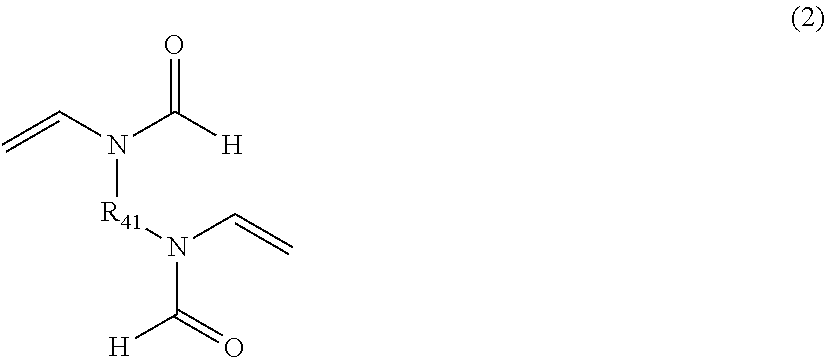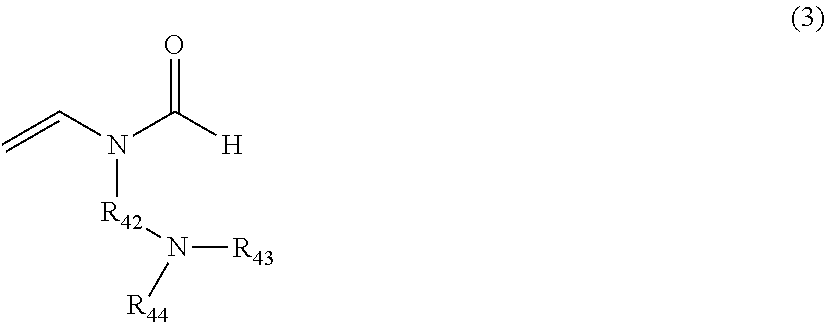Crosslinked polyvinylamine, polyallylamine, and polyethyleneimine for use as bile acid sequestrants
a technology of bile acid sequestrants and crosslinked polyvinylamines, which is applied in the direction of drug compositions, cardiovascular disorders, metabolic disorders, etc., can solve the problems of increased risk of coronary heart disease, reduced patient compliance and tolerance, and large dose requirements
- Summary
- Abstract
- Description
- Claims
- Application Information
AI Technical Summary
Benefits of technology
Problems solved by technology
Method used
Image
Examples
example 1
Preparation of N,N′—(Cmalkane-1,m-diyl)bis(N-vinylformamide) crosslinking monomers
[0136]
[0137]A dry 250 ml Schlenk flask was equipped with a magnetic stir bar, dropping funnel, and sealed with a rubber septum. The flask was purged with nitrogen and charged with N-vinylformamide (3.24 g, 45.6 mmol) and anhydrous THF (100 ml). The flask was cooled to 10° C. in an ice bath, and potassium tert-butoxide totaling 5.57 g (45.6 mmol) was added in three separate portions over 45 minutes through the top of the flask under nitrogen flow. 1,8-Dibromooctane (4.00 ml, 21.7 mmol) was added slowly dropwise to the reaction mixture over 30 minutes. After addition, the reaction was allowed to warm up to room temperature and stir overnight. The solvent was removed in vacuo, and diluted with 150 ml of water. The water layer was extracted with diethyl ether (3×100 ml), dried over magnesium sulfate, and concentrated in vacuo. The N,N′-(octane-1,8-diyl)bis(N-vinylformamide) material was further purified by...
example 2
Preparation of N-(3-tert-butoxycarbonylamino)propyl-N-vinylformamide (N-Boc aminopropyl N-VFA) amine monomer
[0141]A dry 250 ml Schlenk flask was equipped with a magnetic stir bar, dropping funnel, and sealed with a rubber septum. The flask was purged with nitrogen and charged with N-vinylformamide (3.24 g, 45.6 mmol) and anhydrous THF (100 ml). The flask was cooled to 10° C. in an ice bath, and potassium tert-butoxide totaling 5.57 g (45.6 mmol) was added in three separate portions over 45 minutes through the top of the flask under nitrogen flow. tert-butyl 3-bromopropylcarbamate (43 mmol) was added slowly dropwise to the reaction mixture over 30 minutes. After addition, the reaction was allowed to warm up to room temperature and stir overnight. The solvent was removed in vacuo, and diluted with 150 ml of water. The water layer was extracted with diethyl ether (3×100 ml), dried over magnesium sulfate, and concentrated in vacuo. The material was further purified by column chromatogra...
example 3
Preparation of N-(12-(bis-tert-butoxycarbonyl)amino)dodecyl-N-vinylformamide (N-bis Boc aminododecyl N-VFA) amine monomer
[0142]A dry 250 ml Schlenk flask was equipped with a magnetic stir bar, dropping funnel, and sealed with a rubber septum. The flask was purged with nitrogen and charged with di-tert-butyl-iminodicarboxylate (45.6 mmol) and anhydrous THF (100 ml). The flask was cooled to 10° C. in an ice bath, potassium tert-butoxide totaling 5.57 g (45.6 mmol) were added in three separate portions over 45 minutes through the top of the flask under nitrogen flow. 1,12-dibromododecane (100 mmol) was added in three separate portions to the reaction mixture over 30 minutes. After addition, the reaction was allowed to warm up to room temperature and stir overnight. The solvent was removed in vacuo, and diluted with 150 ml of water. The water layer was extracted with diethyl ether (3×100 ml), dried over magnesium sulfate, and concentrated in vacuo. The material was further purified by c...
PUM
| Property | Measurement | Unit |
|---|---|---|
| mean diameter | aaaaa | aaaaa |
| aspect ratio | aaaaa | aaaaa |
| aspect ratio | aaaaa | aaaaa |
Abstract
Description
Claims
Application Information
 Login to View More
Login to View More - R&D
- Intellectual Property
- Life Sciences
- Materials
- Tech Scout
- Unparalleled Data Quality
- Higher Quality Content
- 60% Fewer Hallucinations
Browse by: Latest US Patents, China's latest patents, Technical Efficacy Thesaurus, Application Domain, Technology Topic, Popular Technical Reports.
© 2025 PatSnap. All rights reserved.Legal|Privacy policy|Modern Slavery Act Transparency Statement|Sitemap|About US| Contact US: help@patsnap.com



